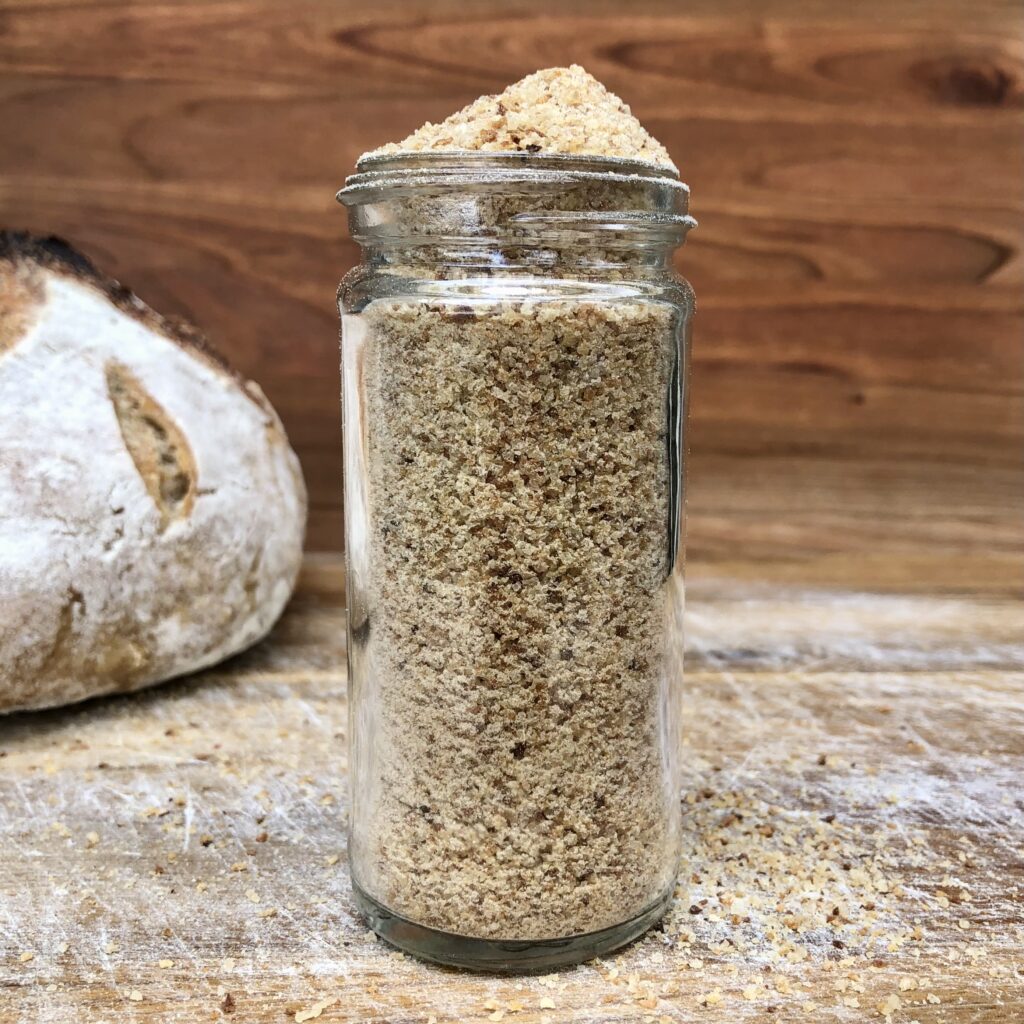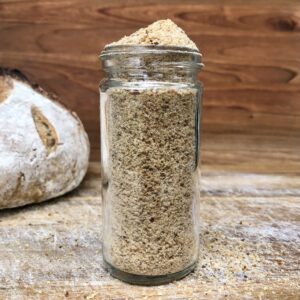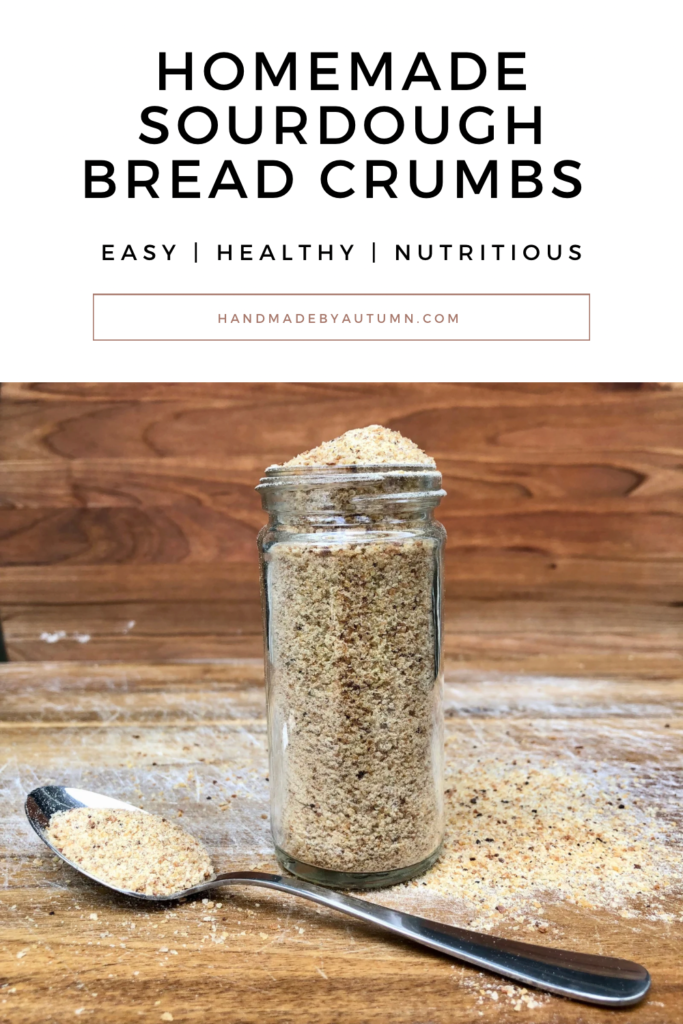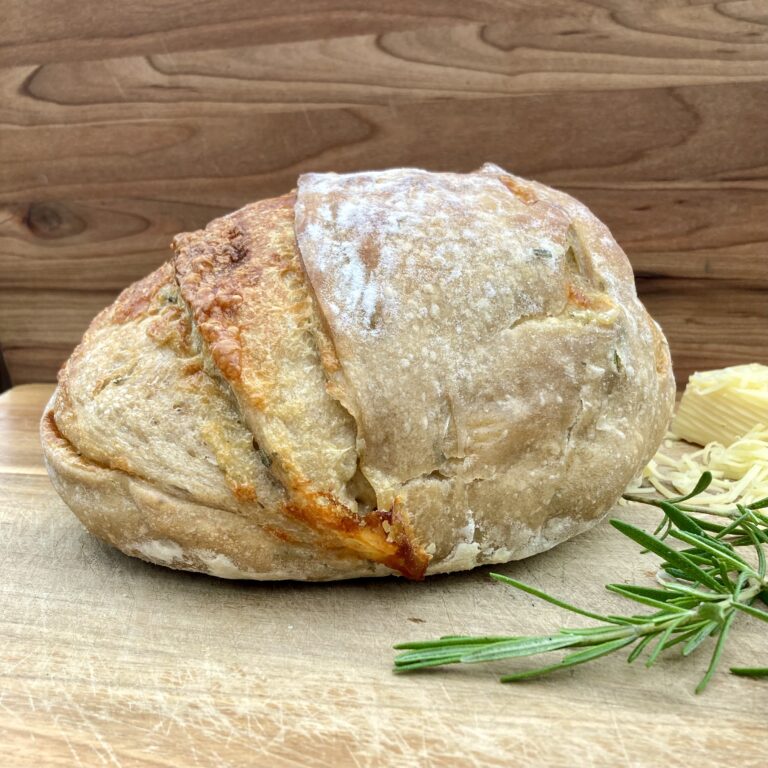Turn your left-over sourdough bread into amazing homemade sourdough breadcrumbs! Sourdough breadcrumbs are oh so delicious, healthier than store-bought breadcrumbs, and they are so easy to make. What a truly fantastic way to use your left-over (or failed) sourdough bread!

I have absolutely loved the journey of learning how to make sourdough bread! Making bread reminds me of the great ability that we have been blessed with as humans to create.
As I create things, whether it be bread to nourish my family or a new sewing project to bless my home with, I am always reminded of the goodness of God- the ultimate Creator of all that is good.
However, the God that we serve is free from error in His creations, but we are not. Far too often, my projects fail. And, sourdough bread is no exception to this.
When I put so much effort into making something like bread, but it falls flat or goes stale before my family is able to fully enjoy it, I automatically begin to think of ways to revive it.
And, my favorite way to revive a lost loaf of sourdough bread is with this Homemade Sourdough Breadcrumbs recipe!
Why are Homemade Sourdough Breadcrumbs so good?
There are so many reasons why you should turn a lost loaf of sourdough bread into breadcrumbs!
First of all, the health benefits of sourdough is transferred to the breadcrumbs. Compared to other types of bread, sourdough breads tend to contain higher levels of vitamins, minerals, and antioxidants; as well as lower levels of phytate (which helps with the absorption of the nutrients).
The process of fermentation also neutralizes the antinutrients commonly found in grains, produces prebiotics, and it breaks down the gluten in the grains. All of these things help to make the bread easier to digest (read more here).
Secondly, turning a loaf of sourdough into breadcrumbs prevents unnecessary waste. After going through all of the effort to make a loaf of bread, the last thing that we want to do is throw it out if it falls or goes stale.
I personally enjoy making my sourdough into breadcrumbs because I know that I will eventually use the breadcrumbs (they last forever if frozen). This means that I didn’t waste my time, energy, and money into something that didn’t turn out.
Lastly, good bread makes fantastic tasting breadcrumbs. High quality ingredients typically create a high quality product. This means that a good loaf of sourdough bread can be used to make fantastic breadcrumbs, and these breadcrumbs will be used to further improve the taste of whatever you choose to put them in.
What do I need to make homemade breadcrumbs?
Another reason to love homemade breadcrumbs is that they require minimal ingredients and equipment.
The most important piece of equipment that you will need is a food processor or a high-powered blender. A food processor or a blender is necessary to properly crumble the bread. I did attempt to make breadcrumbs once by crushing them with a wooden spoon, but it unfortunately didn’t work
The other pieces of equipment that you will need is an oven (to dry the bread out with), a baking sheet (to put the breadcrumbs on), and a knife/cutting board (this is optional as you can also use your hands to rip the bread).
What type of bread should I use?
I prefer to use sourdough bread because of the taste and health benefits. However, you can use any type of bread to make breadcrumbs! Whole wheat, white, whole grain, gluten free, French bread, and buns all work well to make breadcrumbs.
What should I do if my bread isn’t crumbling in the processor?
A common problem with making homemade breadcrumbs is that the bread doesn’t fully crumb in the blender/processor. However, have no fear! There is an easy fix to this problem.
First, test your bread by squishing one of the larger crumbs between your fingers. Does the bread spring back (even in the slightest)? If so, this means that your bread hasn’t dried out all of the way.
Fix this problem by spreading the breadcrumbs back onto a baking sheet and returning them to the oven until they are fully dried. Then, you can continue to process the bread.
If you squish the bread and it appears to be fully dried, continue to process the bread. It may take some time, so I encourage you to be patient.
A final reason that the bread may not be crumbing properly is that there is too much bread in the food processor. Make sure to processes the bread in batches (I typically do 3-4 batches per loaf of bread).
How should I store homemade breadcrumbs?
It is best to store homemade breadcrumbs in an airtight container, such as a mason jar or a Ziploc bag.
Breadcrumbs can be stored at room temperature, however I prefer to keep mine in the fridge in order to ensure that they stay fresh for longer. I have left breadcrumbs in the fridge for up to 2 months without them going bad.
Another great option is to store the breadcrumbs in the freezer. They will last indefinitely if frozen.
No matter where you store the breadcrumbs, consider them bad if they develop mold, get really dry, or develop a funny taste and/or smell.
What should I use Homemade Sourdough Breadcrumbs in?
Homemade breadcrumbs can be used in so many recipes! I personally enjoy using breadcrumbs in meatloaf, meatballs, and homemade chicken strips. Homemade Sourdough Breadcrumbs can also be used as a replacement in any recipe calling for Panko Bread Crumbs.

Homemade Sourdough Breadcrumbs
Equipment
- Food Processor or High-Powered Blender
- Baking Sheet
- Knife & Cutting Board (optional)
Ingredients
- Sourdough Bread any amount will work
Instructions
- Preheat the oven to 300 degrees.
- Cut or rip the bread into approximately 1/2 inch sized pieces and lay them on a baking sheet in a single layer.
- Bake the bread for 14 minutes and then check for doneness. The bread should be dry and hard, but not browned.
- Add the bread to a food processor or a high-powered blender (you will most likely need to do this in batches). Pulse the bread until it forms into very small crumbs.
- Store the breadcrumbs in an airtight container. I recommend keeping the bread in either the fridge or the freezer to help it maintain its freshness.
Notes





